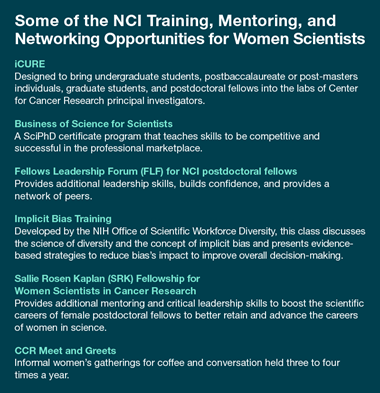The 2019 U.S. Census revealed that the percentage of women working in life and physical science occupations has nearly tripled since 1970. Women now represent 45 percent of employees in science, technology, engineering, and mathematics (STEM).
Yet according to the National Institutes of Health (NIH) Office of Intramural Research, women constitute less than 23 percent of the senior investigators at NIH, even though at least half of the medical (M.D.) and doctorate (Ph.D.) degrees in the life sciences are awarded to women.
Women Scientists Advisors (WSA) was established in 1993 based on recommendations of a task force established by then NIH Director Dr. Bernadine Healy and chaired by Dr. Hynda Kleinman. The committee comprises elected representatives from each NIH Institute or Center who volunteer their time to support other female scientists on issues ranging from pay equity to work/family balance and leadership opportunities.
The Center for Cancer Research has eight elected representatives, including NCI at Frederick representative Kathrin Muegge, M.D., senior investigator in the Mouse Cancer Genetics Program.
She wants to help support the next generation of women scientists by modeling equity in her own lab and by getting involved with the WSA to help raise awareness of issues women in the field encounter.
Muegge believes that despite having made progress in leveling the playing field over the last few decades, a degree of gender bias still exists for female scientists. “In general, I think you have to work harder as a woman,” she said.
Recognizing Gender Bias
When she first began working at NIH in 2001, Mary Kearney, Ph.D., deputy program director of the HIV Dynamics and Replication Program, admits gender bias hindered her advancement. But it didn’t come only from outside sources.

“I harmed my own career by my own gender bias,” she recalled. “Early in my career I felt so lucky to be at NIH that I would never have asked for higher pay, better title, etc. But I finally realized that was wrong. It took me 20 years to feel comfortable advocating for myself.”
Today, she willingly shares her time and “lessons learned” with other young female scientists and is committed to doing her part to plug the infamous “leaky pipeline”—the alarming number of women scientists who end up leaving the field.
Whether they drop because of a sense of lack of advancement or because they don’t feel they can balance a career in science with having a family, Kearney wants to create an environment for women that allows them to pursue their professional and personal interests.
“There are women in science who are able to balance it all, but it might mean you have to prioritize and delegate and outsource in your home life,” she said. But it also includes setting reasonable expectations for what can be accomplished in an eight-hour day in the laboratory.
Kearney believes that many people think a career in science means working evenings and weekends, but she’s out to prove them wrong. “My lab has limited night or weekend hours, and if you look at the numbers, our lab matches or exceeds many others in productivity. It can be done,” she said.
Speaking Up to Move Up
That message resonates deeply with Mary Grace Katusiime, Ph.D., a visiting postdoctoral fellow in Kearney’s laboratory.
Katusiime represents the next generation of women scientists who are determined to “have it all.”
“Like other young women today, Mary Grace is more comfortable advocating for herself, what she wants and what her goals are,” Kearney said.
When Katusiime learned about the NCI Center for Cancer Training Diversity Career Development Program (DCDP), she told Kearney she wanted to participate in the year-long fellowship.
“The program was a deeply introspective process which helps you grow into your values and goals,” Katusiime said. By working with a series of coaches and mentors, she developed a clear idea of how to meld her passion for science with her other life goals, which include having a family of her own someday.
She has determined that her next career step will be to learn how to create and facilitate training programs that recruit and support the next generation of scientists, including under-represented groups and those from the developing world. She wants to help them be actively involved in scientific research that impacts their own communities.
For example, “HIV today is largely an epidemic of the developing world,” she said. “In Africa, there is a need to build capacity so young Africans can address the problem on their own continent.”
The support from her mentors and the DCDP program has enabled her to take an idea that she originally thought was “pie in the sky” and see that it’s possible.
Fostering the Next Generation of Mentors
Katusiime credits Kearney’s mentorship for helping her realize that there’s more to life than simply science in a laboratory. “I can enjoy science as a career and contribute to the world, but also be an individual with other dreams,” she said. “Because at the end of my life, I don’t want to look back and see just science. I want to believe I impacted people and lives by living my values.”
She intends to take many of the lessons she has learned from working in Kearney’s laboratory and model them for the young scientists she hopes to mentor herself someday. That includes recognizing that despite differences in ages, ethnicity, or gender, we can all learn from each other.
Muegge agrees, adding that one of the biggest lessons she tries to impart on her mentees is simple: “You should never get stuck. There are always resources and people who can help you.”


